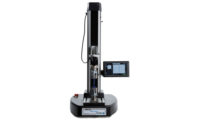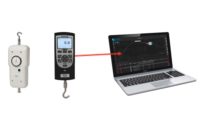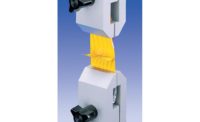Variability in force test results due to incorrect selection of grips and fixtures can be minimized by simply using the proper grips and fixtures. There are many universal solutions available, but will the universal grip or fixture hold up to the test?
Many factors come into play when choosing the right mounting hardware to ensure the specimen is properly aligned: it doesn’t slip in the grip, it has the correct force rating, it provides flexibility and interchangeability. A force tester equipped with the correct grips and grip faces for the application will provide test results true to the specimen tested. A specimen that breaks or slips in a grip due to incorrect grip faces will have a negative effect on the test results.
The graphs below demonstrate a tensile test performed in two different scenarios: with Wedge grips when slippage occurs due to incompatibility of grip faces and when the proper grip / specimen combination is used for the test with no slippage.
In the second graph, the correct grip faces are used. This means that there is no slippage during the test, and that the test results have minimum error induced by incompatible grips.
Below is an overview of the most common grip types used when performing tensile testing as well as
the types of tests for which they
are designed.
With the infinite choice of grips and fixtures available on the market, test machine manufacturers will often offer to test the specimens, provide test results, and recommend the grips and fixtures needed for the test. This will eliminate the risk of making the wrong choice especially if you are not an expert.
Different Types of Grips
By definition, a grip is “to take and keep a firm hold of; grasp tightly.” The key to obtaining reliable test results depends on a grip holding on to the specimen without it breaking or slipping.
Wedge action tensile grips are the most commonly used self-tightening type of grips. The advantage of a wedge action grip is that as force increases, the wedges are progressively pulled together increasing the pressure against the specimen. Another benefit of a wedge grip is the constant gripping pressure on the specimen as the specimen shrinks during elongation. Initial force can be applied by various methods such as side lever, capstan action wheel or screw action.
Faces are interchangeable for different specimen material and dimensions. Serrated jaw faces are well adapted for plastics, composite material and metals. The selection of the serration pattern and grit is important based on the material to be tested to prevent slippage.
Serrated V-grove shaped jaws are ideal for testing wire and tubing. Softer materials, such as films, thin sheets, bands and paper, require smooth or rubber-coated surfaces to minimize slippage. Maximum opening and load capacity of the wedge grip must be considered based on the specimen tested.
Vice grips are manually tightened via a thumb screw or T-bar. The grips could be single action or dual action and allow for offset specimen alignment for shear testing. These grips are ideal for all types of flat specimens, such as rubber, plastic film, plastic dumbbells, paper or cardboard, sheet metal, foils, wood, fabrics and composites (depending on the rating). There is also a cost advantage of vice grips over wedge grips due to the simplicity of the design.
Eccentric/self-tightening roller grips tighten as the specimen is pulled. These grips are also ideal for all types of flat material, such as rubber, plastic film, plastic dumbbells, tape, paper or cardboard, sheet metal and foils.
Incorrect grip faces and/or grip pressure could lead to slippage. Adjusting the pressure of the grips could be an easy fix to prevent slippage or changing the jaw face pattern to a coarser grit.
Different Types of Fixtures
By definition, a fixture is “a device for supporting work during machining.” In force testing, a fixture holds or supports a specimen rather than gripping it. Optional T-Slot tables or multithreaded bases, also known as jigs, may be added onto a force tester to mount custom applications and assemblies.
Bend and flexing fixtures are for bending materials such as plastic, fiber, boards, and metals at specific lengths on three to four points using anvils or rollers. The length between points are adjustable with linear scaling to locate the pillars for accurate positioning.
T-Slot and multithreaded fixtures are used when specimens need to be tested as an ensemble with custom fixturing. This solution provides flexibility for locating the specimen even if the force to be applied is offset. The grip combined with a multithreaded base plate allows mounting flexibility while maintaining the specimen stable during the test.
Conclusion
Making the right decision is crucial for selecting the correct grips or fixtures for the materials being tested. It is important to understand how the incorrect grips or fixtures may negatively affect the tests results. These are variables that can be minimized and controlled based on multiple factors such as: grip faces, load alignment and type of grip or fixture being used. Making the right choice between a grip or a fixture should be based on the requirements of the material being tested, the specimen size, budget and the size of the assembly needed to be tested. Q









